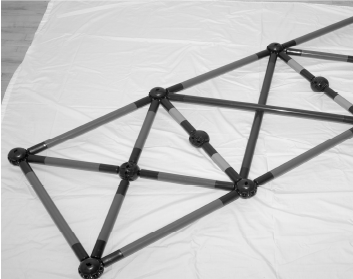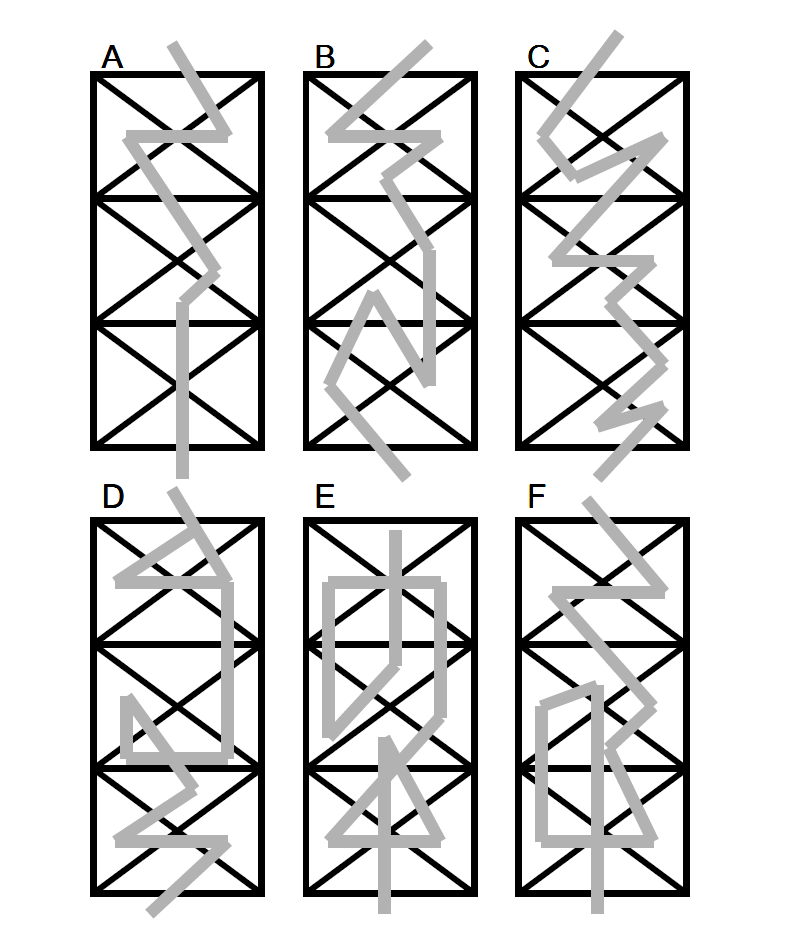“Many attempts to communicate are nullified by saying too much.”
Robert Greenleaf
Setup Time: 10 minutes
Materials
Activity: 20 – 45 minutes
Debrief: 20 minutes (minimum)
Group Size: 4 – 24 participants per set of Toobeez
Space: 20 x 20 (minimum room size)
Open space – no chairs, tables, etc.

Find Your Way
Place the Toobeez on the floor in the pattern indicated in the diagram. The Toobeez pieces will act as the frame. The maze is the path they must follow to navigate through it. See picture at left for the layout of frame. You will need:
Choose a maze map from page 45 (you will need to have a sketch
or copy of the map maze in your hand during the activity).
Clearly outline the instructions and answer any questions before the activity begins.
Facilitator Script
There is only one correct way through this Toobeez maze from point A to point B (indicate beginning and end to the participants). The object of the activity is for you to determine what that correct path is and then have as many of you go through the maze as possible in the time allotted.
You must adhere to the following guidelines:
You will have 30 minutes to complete this activity. As a group you
may decide how much of that time to use for planning before the
first person enters the maze. (Thirty (30) minutes is based on using
a medium difficulty maze for 12 people).
Any questions on the material covered? (Answer any questions).
Begin.

Maze maps
“Maze maps” – pick one route to follow, beginning at either end.
The timeframe is meant to create a sense of urgency. If you find participants are moving too quickly, reduce the time. You can excuse it with, “Another unexpected obstacle, the time has been cut by X minutes, there are now Y minutes remaining.”
Once the activity begins, your role as facilitator is two-fold. For that reason, this activity works best with an assistant or cofacilitator in the room. One of you will observe behaviors while the other can hold the maze map and beeper. The person with the maze map and beeper needs to stand with a clear view of the map, the actual maze, and the participants as they work through the maze. Anytime you see someone make a move that is not in accordance with the maze map being used, beep that person and send them to the back of the line.
For the person observing, listen and look for the following: How people cooperate, work together, and communicate. The questions below, based on the primary Learning Intentions, are provided to guide your observations.
Teamwork and Cooperation
People will have different ideas of what their “team” is and whether they “need” a team. The possibility here is for people to see that they can all work together creating a bigger possibility of “winning” than any individual can create on his/her own. During the activity, observe:
Communication
In this activity, communication is controlled by the guidelines of the exercise. People may strategize before beginning or they may jump right in. Once anyone has begun to go through the maze, everyone is limited to nonverbal communication. How do they exchange ideas with their teammates? Listen, watch, and notice:
When the time has elapsed, stop people where they are and bring the participants together to debrief.
The debrief should be an interactive discussion. Lead it by offering a series of questions and soliciting responses from the participants. To begin, ask questions about the activity itself and continue with specifics related to the skills you want to address or highlight. You may stick to one area of focus or choose to cover many topics. Suggested questions are offered below to guide you as you facilitate this debrief.
The debrief is organized with an Opening and Closing and then by Learning Intention, and it may be used in a variety of ways. You may use just the Opening and Closing for a basic debrief or add the Learning Intention-specific debriefs in between. To include the Learning Intention specifics in your debrief, either pick one or two questions from each area in order to touch on many topics, or work in depth on one or more areas of learning and go through all of the questions for that topic(s). Look through the questions, TIPs, FCs, and Transitions prior to the training session in order to choose which ones you will cover (see “How to Use this Book”).
The intention of this activity is to enhance communication, trust, and cooperation among the participants. However, this activity offers many lessons, so let the participants share with you what they learned and their comments as to the purpose of the activity.
This activity is a platform for new actions. We navigate “mazes” without maps all the time. Clear communication, a team focus, responsibility for everyone’s outcome, and openness to guidance are critical to everyone’s success.
Concluding Questions
Action Plans
Teamwork and cooperation includes how people interact with each other, the roles people take in group settings, and how people perceive situations – as competitive or collaborative.
Teamwork
Cooperation
Summary Script
When people work together in an empowering way – one in which everyone is listened to and respected as a contributing member of the team – results are impacted. We often interpret situations as us versus them, when all parties would benefit by working together. As we expand our interpretation of “team”, we also expand the possibilities for success and achievement.
“Now that we have an idea of the impact of Cooperation and Teamwork, we’re going to look in depth at one of the main building blocks – excellent Communication.”People are always engaged in many levels of communication. The following questions offer participants the opportunity to become aware of their communication, the impact it has on others, and the results it creates. Through this awareness, people will then get to choose the alternatives that serve their goals..
Speaking
Listening
Nonverbal
Summary Script
Research has shown that 90% of human communication is nonverbal, yet we rarely focus on it. This activity provides an in-depth look at nonverbal communication and how powerful and effective it can be. Now you can put that information into action to create clear and comprehensive mutual understanding. How will this impact your organization?